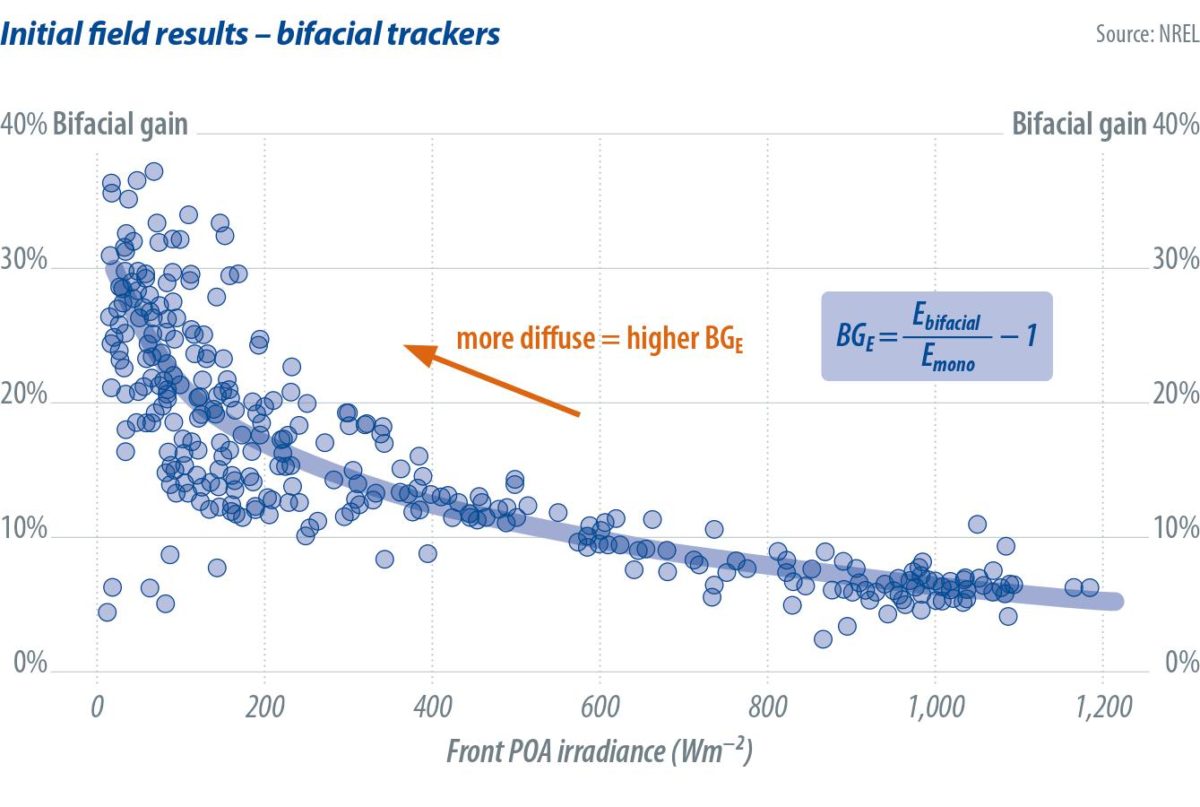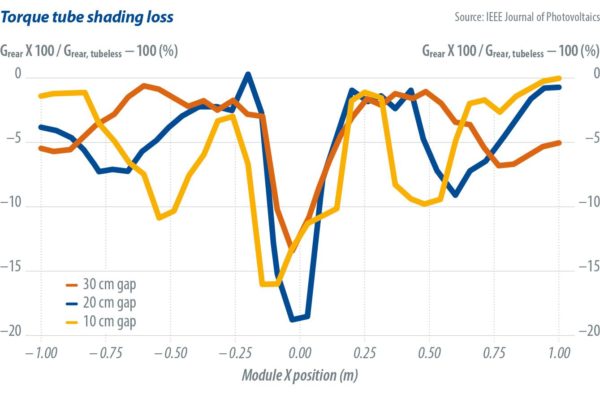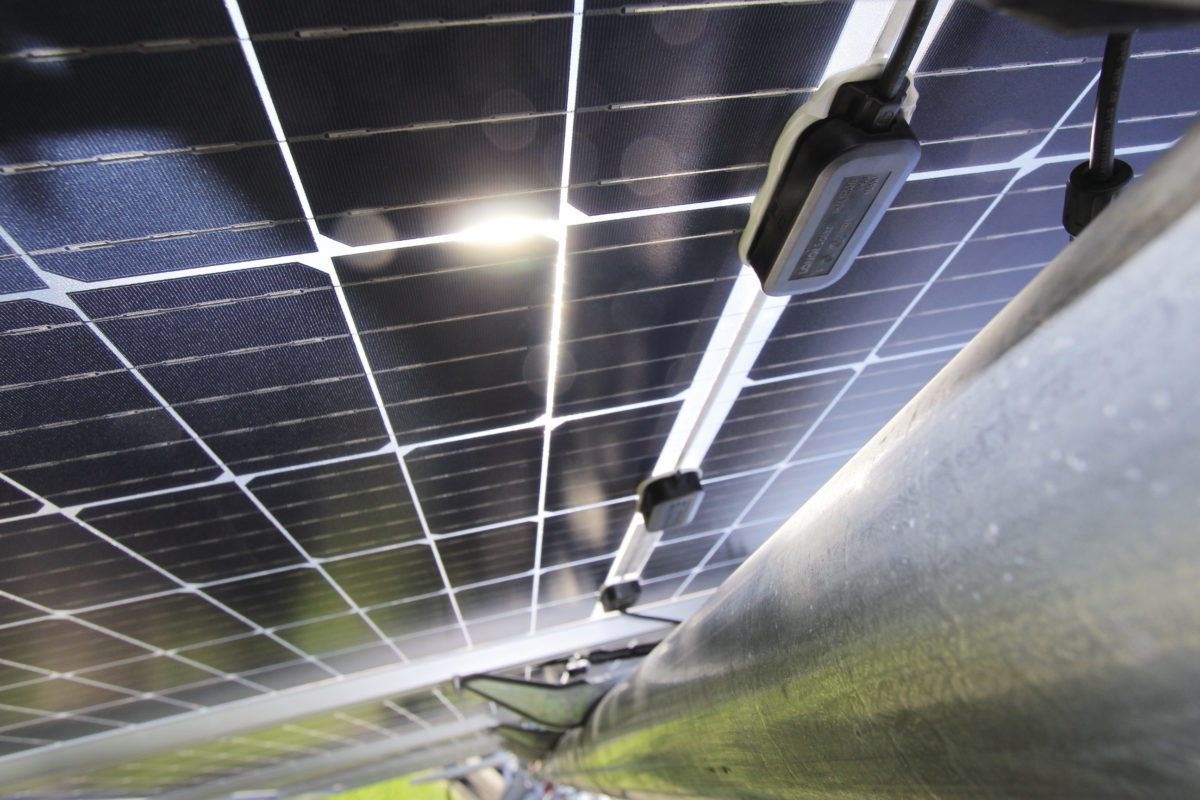From pv magazine 01/2020
With monofacial PV modules and trackers now on the market for decades, the industry has had ample time to optimize the two. There is little theoretical uncertainty in terms of performance, and over the past year, global annual tracker installations have increased by a margin of 40% to reach more than 20 GW, according to IHS Markit. That number is set to grow at record speeds, analysts say, not least because of the assumed symbiosis of single-axis tracking and bifacial modules.
This symbiosis, however, is still in its infancy. While suppliers of trackers and modules tout monumental yield gains of up to 30%, the reality remains unclear, and a precise figure for the power gains that can be achieved is not easily arrived at.
In pursuit of an answer to the question of how much power output can be expected, tracker suppliers around the globe have teamed up with renowned solar research institutes. These efforts extend beyond front-side yield optimization to an understanding of what actually happens on the rear of the module.
Among those tracker suppliers is U.S.-based Nextracker. The company’s CEO, Dan Shugar, says that he was first introduced to the idea of bifacial modules in 1991; as early as 2007, his company supplied dual-axis trackers to the 14 MW Nellis project, near Las Vegas. Commissioned 12 years ago, the site was the country’s largest utility-scale array at the time, and around 20% of the modules supplied to the site were bifacial. Shugar says that Powerlight, the company he worked at before NExtracker, already in 2007, had supplied a purpose-built bifacial tracker. A lot of testing and validation went into bifacial designs at that time, and definitely more has in the interim, he adds.
Front-side domination
Tracking algorithms, for the most part, are astronomically oriented. The sun will return to the same spot in the sky on Jan. 13 every year, for example. Over the last two decades, tracker suppliers have repeatedly tweaked that algorithm to increase yield. The first such tweak was backtracking.
Backtracking mode involves the module being tilted off the ‘perfect’ azimuth to avoid row-to-row shading during morning and evening hours. In a later development, some companies started to optimize their trackers to increase production in diffuse light conditions. The tracker moves the tables to a near-horizontal position during cloud cover. Not at each cloud passing, however, but controlling the module rows in a more elaborate fashion. The specification as to how the trackers backtrack and react to cloud cover sets the various suppliers apart.
Bifacial modules are understood to perform particularly well in diffuse light conditions, which makes the combination of bifacial modules and a tracking algorithm that’s optimized for diffuse light conditions so interesting. “Bifacial gain is how much the back is contributing in relation to the front,” says Silvana Ayala Pelaez, a bifacial PV analyst for the National Renewable Energy Laboratory (NREL) in the United States.
In regions where there is ample direct irradiation, the rear-side gain will be high in terms of total measured power output, but in terms of percentage gains in relation to the front, it will be quite low. “It is a tricky metric to understand. Your bifacial gain is actually really better on cloudy days,” Pelaez explains.
Prior to the rise of bifacial technology, single-axis tracking was primarily confined to regions with high direct normal irradiance content. With the advantages of bifacial modules playing out particularly strongly in conditions of high diffuse light content, Pelaez stresses that new markets could eventually open up. Comparing Phoenix, Arizona, to Seattle, Washington, the bifacial researcher estimates that diffuse light optimization in bifacial tracking algorithms gives a 1% to 2.5% advantage in the more northern of the two cities.
“Sunny markets have seen activity for quite some time, but now we see markets penetrated where a few years ago you would not think to put solar panels. In a lot of locations in the north of the U.S., when people think of solar panels they think of bifacial panels, because of this added power and reflectivity in diffuse light in high latitudes,” Pelaez says.

The emergence of bifacial considerations in less sunny locations warrants the question as to whether tracker suppliers have really optimized their tracking algorithms for bifacial applications. When quizzed about Nextracker’s advancements in this field, Shugar is forthright in his response: “Front side performance dominates!” Reportedly, Nextracker has verified this result both analytically and empirically throughout its testing regime.
Shugar sets out why front-side performance should prevail with a simple example. If the irradiation is about 1,000 W per m² and the ground cover ratio is about 40%, then 400 W is going to hit the modules’ front side at high noon. The remaining 600 W will hit the ground between the modules. Assuming an albedo of 0.3, around 180 W are going to be reflected off the ground. No small feat, but one must consider that quite a bit of those watts will be reflected between the panels. A fraction of that 180 W will be scattered onto the rear side of the modules, but how much is not a straightforward answer (see article titeled “All about albedo” in this issue for a discussion on modeling). In terms of genuinely bifacial specific tracking algorithms Ayala-Pelaez, too, reveals that according to her observations, such algorithms are still in their infancy. Notably, in diffuse light conditions, there are theoretical gains in tweaking the tilt angle ever so slightly to increase the diffuse light content reflected off the ground.
“At least from the modeling situation, horizontal tilt is not always the best for bifacial, and I know that there are people working on it.” That said, Ayala-Pelaez reiterates that she doesn’t believe that any company has yet come up with bifacial algorithms. “We are still trying to really understand the rear irradiance itself and get the modeling and its validation right,” she says.
Trina Solar claims that its integrated TrinaPro solution – which combines Nclave-built trackers with Trina modules, Sungrow inverters, and a range of proprietary management software – has been optimized to follow a bespoke tracking algorithm for bifacial modules. The algorithm promises yield gains of about 3-5%, according to Trina. When pv magazine approached the company to explain how these gains are achieved, a representative reasoned that doing so might reveal how the company is able to achieve its claimed power gains, which would undermine its competitive advantage.
Shugar says that Nextracker has worked on a new third mode of tracking, which will improve yields for bifacial modules, although not precisely because of their bifaciality. The trend toward half-cut cells and dual- or split-module designs has come to dominate manufacturing. And these module configurations affect tracker operations. Many bifacial modules on the market today deploy this design feature.
Dual module configurations have an electrically independent top and bottom half. During morning and evening hours, the tracker goes into regular backtracking first, before going into full shadowing of the bottom half of the module. The tracker will then only backtrack the top half of the module. It is half true tracking and half backtracking, Shugar explains. According to Nextracker’s research, this results in higher yields during the morning and evening hours.
The tracking algorithm, however, exploits the modules’ function of having a bottom and top half, rather than having a front and rear side. “That algorithm has an impact, but the structural adaptations have a much higher impact,” Shugar explains.
Low-hanging fruit
It is really important what is happening under the module in the actual structure,” Shugar says. It is not just important to increase irradiation on the back, but also to achieve as much uniform irradiation as possible. Different irradiation conditions on the rear side can cause module mismatch, which in turn lowers the power output for the entire module.
One phenomenon that has been observed by Sandia and NREL, for example, is edge brightening. A team of researchers around Pelaez modeled rear irradiance and bifacial gain uniformity for a row composed of 20 modules. The team found that the two parameters increased by 25% within five meters of the row edge on the south, and by 10% from the row edge to the north, in a northern hemisphere location.
Mitigating this effect will prove challenging, as it has nothing to do with the structure of the racking. But another cause of rear irradiance non-uniformity has actually been the subject of heated debate between tracker suppliers – the torque tube. Avoiding rear-side shading by the structure has become a paramount task for suppliers. In response to this, Nextracker has introduced its two-in-portrait (2P) Gemini tracker system. “The bearing is not behind the module, the damper is not behind a module,” Shugar says. Every few meters where there is a post, there is a small gap between the modules. In this space, Nextracker has squeezed in all the additional system components, including control boxes, sensors, and bearings.
For the one-in-portrait version of the tracker (1P), the company developed mounting rails that elevate the module from the tube. The tube itself is round and shiny, reflecting as much light as possible back onto the module. “Also what we see is that most bifacial modules have this region in the middle, which is transparent,” Shugar explains, referring to dual-module designs that locate their bypass diodes in the middle. Light can penetrate through the small gap, so it is reflected off the torque tube onto the module’s rear side.

In a simulation in which NREL looked at the torque tube shading losses for a single day at different gaps, the team found that for a tube diameter of 10 cm at 0.75 m installation height, there are losses on the rear irradiance of about 15-20%, if the modules are closest to the tube. However, even at 30 cm, the team found considerable shading lobes of nearly 15%, with severe inhomogeneity in the measured values. Shugar says that in his view, an optimized 1P tracker performs as well as a regular 2P tracker on the inhomogeneity metric.
The inhomogeneity in irradiation levels on the back accounts for the bulk of losses that happen to a bifacial tracking installation. Playing with installation height, row width, and ground albedo offers serious potential to increase a plant’s output by a few percent. Further tweaking of the structure to achieve as much uniform irradiance as possible is the next step in tracker optimization. In terms of algorithm tweaking, more work needs to be done. But the potential of considerable gains in regions with more diffuse light conditions could see trackers and bifacial modules capture new markets for PV and for trackers. An expanded solar and tracker map: That makes it worthwhile to pay more attention to the back.
This content is protected by copyright and may not be reused. If you want to cooperate with us and would like to reuse some of our content, please contact: editors@pv-magazine.com.









3 comments
By submitting this form you agree to pv magazine using your data for the purposes of publishing your comment.
Your personal data will only be disclosed or otherwise transmitted to third parties for the purposes of spam filtering or if this is necessary for technical maintenance of the website. Any other transfer to third parties will not take place unless this is justified on the basis of applicable data protection regulations or if pv magazine is legally obliged to do so.
You may revoke this consent at any time with effect for the future, in which case your personal data will be deleted immediately. Otherwise, your data will be deleted if pv magazine has processed your request or the purpose of data storage is fulfilled.
Further information on data privacy can be found in our Data Protection Policy.